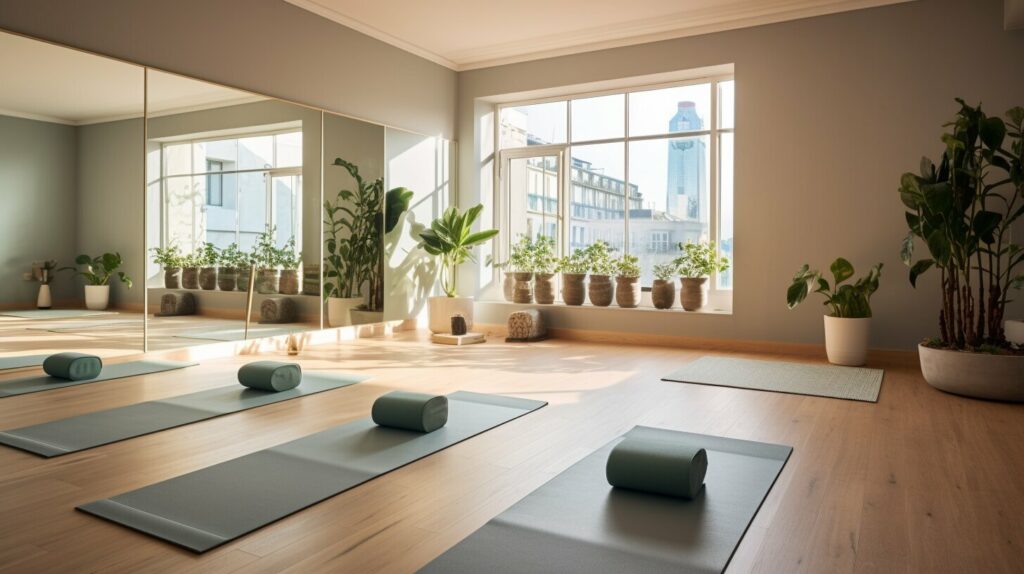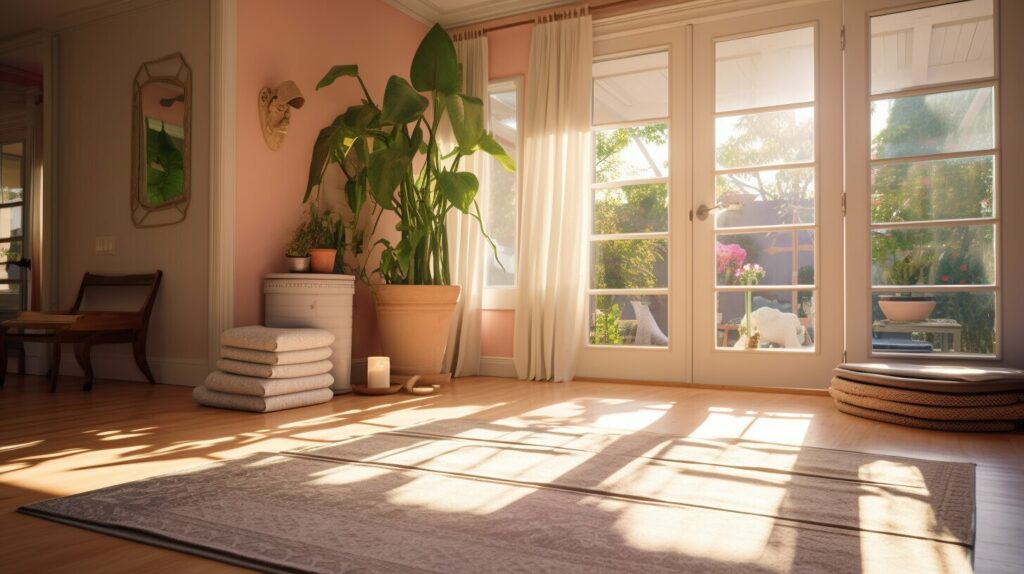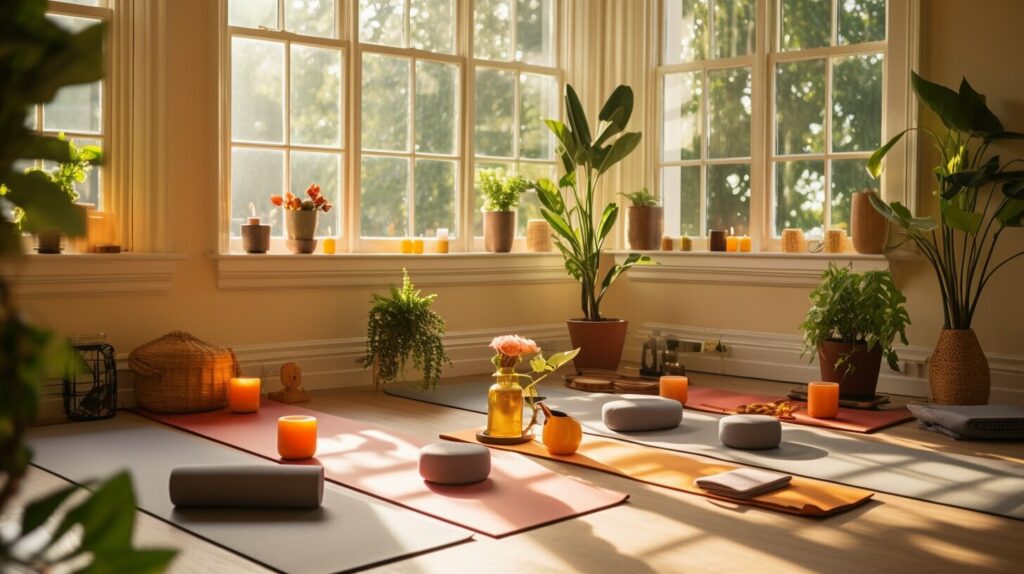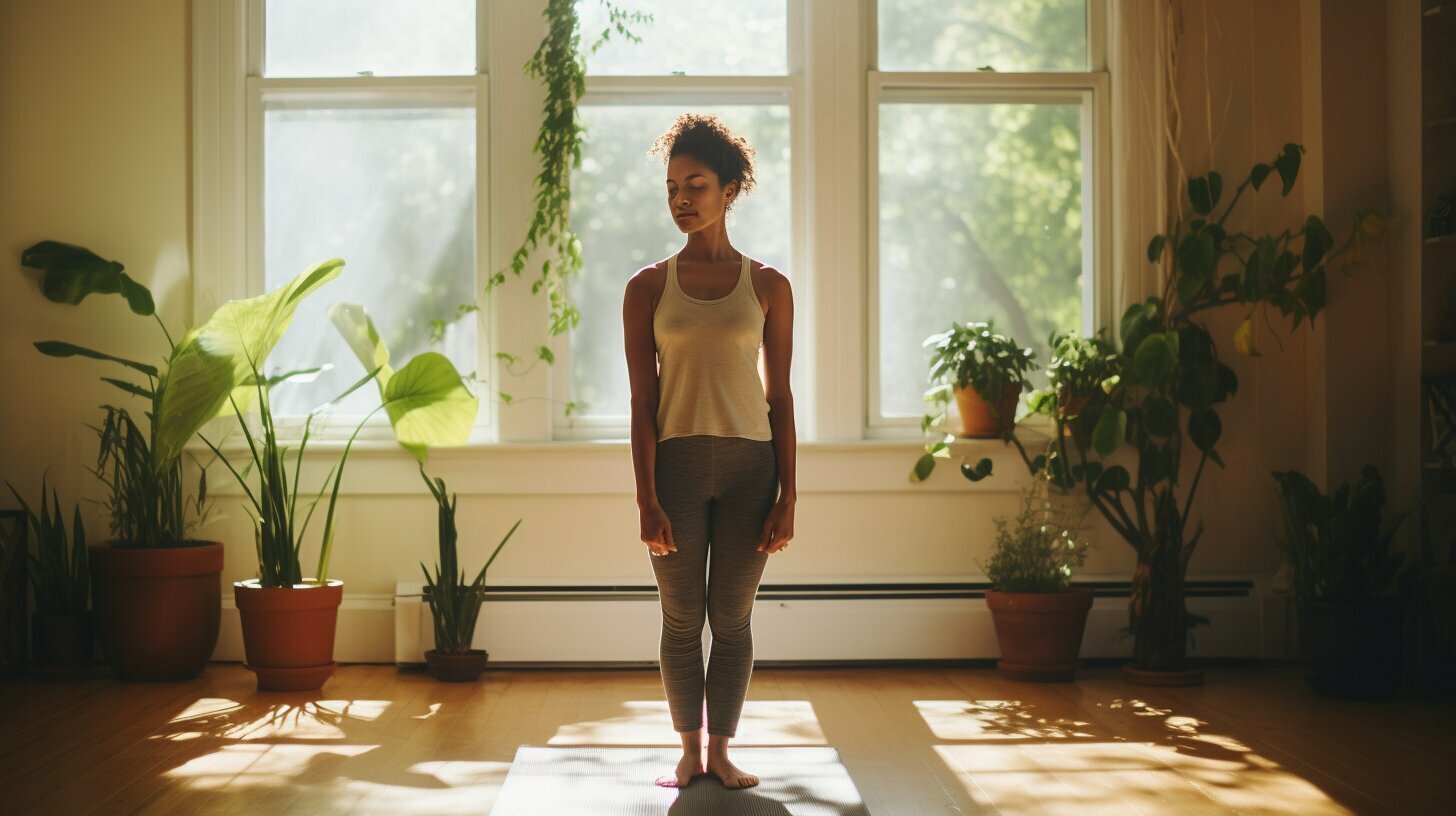Are you a yoga enthusiast looking to turn your passion into a business? Do you dream of running your own yoga studio but find the thought of sky-high rent, long-term leases, and overhead costs daunting? You may be surprised to know that it is entirely possible to run a successful yoga studio right from the comfort of your own home. In this comprehensive guide, we will explore the steps and requirements to make your dream of operating a home-based yoga studio a reality.
- It is possible to run a successful yoga studio from home.
- Running a home-based yoga studio comes with several benefits, including cost savings and flexibility.
- Setting up a dedicated space with proper equipment and props is essential.
- Understand the legal requirements and permits necessary for running a yoga business from home.
- Effective marketing strategies and a supportive community are crucial for building a clientele.
Benefits of a Home-Based Yoga Studio
If you’re considering starting a yoga studio, setting up a yoga studio at home can be an excellent option. Running a yoga studio from home comes with several advantages that make it an attractive choice for many yoga teachers.
Flexible Schedule
One of the most significant benefits of a home-based yoga studio is the ability to set your own schedule. You can choose to teach classes at times that work best for you and your clients, without being restricted by the hours of a commercial studio.
Cost-Effective
Starting a yoga studio can be a significant investment, with costs associated with renting or buying a space, utilities, maintenance, and equipment. When you have a home-based yoga studio, you can save on overhead costs, making it a more cost-effective option.
Personalized Space
With a home-based yoga studio, you have the flexibility to create a unique and personalized space that is tailored to the needs of your clients. You can choose the flooring, lighting, and ventilation that work best for your classes, and decorate the space to create a welcoming and calming environment.
Comfort and Convenience
Teaching from home also means that you have all the comforts and conveniences of home. You don’t have to commute to a studio, and you can teach in a space that is familiar and comfortable to you.

Starting a yoga studio can be an exciting and rewarding venture, and setting up a yoga studio at home can make it more accessible and achievable. With the benefits of a home-based yoga studio, you can create a successful business that allows you to do what you love while providing a valuable service to your community.
Creating the Perfect Home Yoga Studio Setup
Setting up a dedicated space for your home-based yoga studio is essential. Here are some key elements to consider:
Flooring
Invest in high-quality flooring that provides cushioning and support for your students during practice. Yoga mats should not slide on the surface. Opt for materials like cork, bamboo, or hardwood to create a natural and peaceful environment. Consider adding a rug for warmth and additional cushioning.

Lighting plays an important role in creating the ambiance of your studio. Natural light is ideal, but if that’s not possible, choose warm and gentle lighting fixtures that are adjustable to suit the time of day. Avoid harsh fluorescent lighting that can be distracting and unpleasant.
Ventilation
A well-ventilated space is crucial in ensuring you and your students are comfortable during practice. Open windows or install an air conditioning system to regulate the temperature and improve air quality. Incorporating plants can also help purify the air and add to the overall aesthetic of the space.
Storage
Make sure to have adequate storage for props and equipment, such as yoga blocks, straps, bolsters, and blankets. Install shelves or cubbies to keep the space organized and clutter-free.
With these essential requirements in mind, you can create a peaceful and functional environment for your home-based yoga studio.
Legal Considerations and Permits
If you’re planning on running a yoga business from home, it’s important to take legal considerations and permits seriously. Even though you’re operating from your own property, there may be regulations and requirements you need to follow to ensure your business is lawful.
One of the first steps you should take is to research zoning laws in your area. Some neighborhoods have restrictions on running a business from home, so it’s important to verify that you’re permitted to do so. If your area requires a business license, make sure to apply for one before you begin teaching classes.
You should also consider liability insurance. Although yoga is a low-impact activity, there is still a risk of injury. Having insurance can protect you in case a student gets injured during one of your classes. It’s always better to be safe than sorry!
Another important legal consideration is record-keeping. Make sure to keep detailed records of your finances and student information. This can be helpful for taxes, bookkeeping, and tracking client progress.
By taking care of legal considerations and permits upfront, you can focus on growing your business without worry. Don’t hesitate to consult with a legal professional if you have any questions or concerns.

Equipping your home-based yoga studio with the right equipment and props is essential to create a comfortable and safe environment for your students. Here are some of the essential items you’ll need:
Yoga Mats
A sturdy and non-slip yoga mat is a must-have for any yoga class. Invest in high-quality mats that provide ample cushioning and traction, ensuring your students are safe during difficult poses. Consider purchasing mats in different colours to add a touch of personality to your studio.

Yoga blocks and bricks are great tools for students who need support during stretches or to deepen their practice. Ensure you have enough blocks and bricks to accommodate your classes, and choose materials that are durable and easy to clean.
Bolsters and Pillows
Bolsters and pillows are excellent additions to any home yoga studio. They provide support for restorative poses and help students relax and release tension. Choose materials that are soft and comfortable, and consider adding removable covers that are easy to clean.
Blankets and Towels
Blankets and towels are versatile props that can be used for a variety of purposes, from cushioning joints to wiping sweat. Consider purchasing organic and eco-friendly options that align with the principles of yoga.
Other Essential Equipment
In addition to the above props, you’ll also need basic equipment such as straps, eye pillows, sandbags, and meditation cushions. Ensure you have enough of each item to accommodate your classes, and choose materials that are long-lasting and easy to maintain.
By investing in high-quality equipment and props, you’ll create a safe and supportive environment that enhances the yoga experience for your students.
Marketing and Promoting Your Home-Based Yoga Studio
Now that you have set up your home-based yoga studio, it’s time to promote your business and attract clients. Here are some useful tips for running a successful home-based yoga studio:
- Create a website: A website is a great platform to showcase your studio, highlight your services, and provide information about your classes. Make sure to include your studio’s location, contact details, and schedule. Also, consider adding a blog section where you can share yoga-related articles and tips.
- Utilize social media: Social media is a powerful marketing tool that can help you reach a wider audience. Create profiles on platforms such as Facebook, Instagram, and Twitter, and regularly post updates about your studio, classes, and promotions. You can also use social media to engage with your followers, answer their questions, and build a community around your brand.
- Network within your community: Networking is a great way to connect with like-minded individuals and potential clients. Attend local events, join yoga groups or associations, and collaborate with other wellness professionals in your area. You can also offer free classes or workshops to attract new students and establish your presence in the community.
- Offer promotions: Offering promotions or special deals can entice new clients to try your classes. You can offer a discount for first-time students or a package deal for multiple classes. Also, consider hosting a referral program where your existing clients can get a discount for bringing in a new student.
By implementing these marketing strategies, you can create a strong brand for your home-based yoga studio and attract a steady stream of clients.

Starting a yoga studio from home can be challenging, especially when it comes to building a loyal client base. However, there are several effective strategies you can use to attract new students and retain existing ones.
Offer Free or Discounted Classes
One effective way to attract new students is by offering free or discounted classes. This can be a great way to introduce people to your teaching style and give them a taste of what your home-based yoga studio has to offer. You can also offer referral discounts to encourage current students to bring their friends and family to your studio.
Engage with Your Community
Engaging with your local community is a great way to spread the word about your home-based yoga studio. You can attend local events, sponsor community events, or even offer free classes at local parks. By establishing a presence in your community, you can attract new students and build a network of support.
Create a Strong Online Presence
In today’s digital age, having a strong online presence is crucial for any business, including a home-based yoga studio. You can create a website for your studio, list your business on online directories, and utilize social media platforms such as Facebook and Instagram to promote your classes and events. By creating engaging content and regularly interacting with your followers, you can attract new students and build a loyal following.

Building strong relationships with your students is key to retaining them and creating a supportive community within your home-based yoga studio. One way to do this is by taking an interest in their individual needs and goals, and tailoring your classes to meet their needs. You can also create a sense of community by hosting special events and workshops, such as meditation sessions or yoga retreats.
By implementing these strategies and providing high-quality yoga classes, you can attract and retain a loyal clientele for your home-based yoga studio. Remember, building a successful yoga business takes time and effort, but with dedication and passion, you can create a thriving community that promotes health and wellness.
Managing the Operations of Your Home Yoga Studio
Running a yoga business from home involves managing various aspects beyond teaching classes. Effective studio management is crucial to ensure a smooth operation and a positive experience for your clients.
One important aspect of studio management is scheduling. Keep track of your availability and create a schedule that works for you and your clients. Consider offering a variety of class times to accommodate different schedules and lifestyles.
Managing client bookings is another essential aspect of running a home-based yoga studio. Invest in a reliable booking system that allows clients to easily book and pay for their classes online. This not only saves time and effort but also offers a convenient and seamless experience for your clients.
Keep accurate records of client attendance, payment history, and other important information. This helps with financial planning, reporting, and client relationship management.
Maintaining a professional and welcoming environment is also crucial to the success of your home-based yoga studio. Keep your studio clean, organized, and well-equipped with all the necessary props and equipment. Consider adding personal touches such as plants, candles, or soothing music to create a relaxing and welcoming atmosphere.
Lastly, do not hesitate to seek support or delegate tasks when necessary. Running a yoga business from home can be overwhelming at times, so make sure to take care of yourself and seek help when needed.

As a home-based yoga studio owner, it’s important to continue your education and professional development to stay up-to-date with the latest yoga trends and practices.
One way to further your knowledge is by attending yoga workshops and conferences. These events provide opportunities to learn from experienced yoga teachers, connect with other professionals in the industry, and discover new techniques and approaches to teaching yoga.
Another option is to enroll in online courses or programs. Many reputable yoga schools offer online certifications that allow you to study at your own pace and from the comfort of your own home. These courses can help you expand your knowledge of yoga philosophy, anatomy, and teaching methodology.
In addition to formal education, it’s also important to continue your personal yoga practice. Set aside time to practice yoga on your own or attend classes taught by other teachers. This will not only deepen your understanding of yoga but also help you stay connected to your own practice and maintain your passion for teaching.
Remember that continuous learning is key to becoming a successful and effective yoga teacher. By investing in your education and professional development, you’ll be able to offer your students the best possible experience and make a positive impact in their lives.

Now that you have explored the possibility of running a yoga studio from home, it’s time to take action and turn your dream into a reality. By following the steps outlined in this guide, you can create a thriving home-based yoga studio that will not only provide a source of income but also positively impact the health and wellbeing of your clients.
Remember, starting a yoga studio at home comes with several benefits, including the flexibility to set your own schedule, save on overhead costs, and create a personalized space for your clients. However, it’s important to be aware of the legal considerations and permits required before getting started.
Setting up a dedicated space for your home yoga studio is also essential. From flooring and lighting to ventilation and storage, the key elements of your studio setup will contribute to creating a peaceful and functional environment.
Attracting and Retaining Clients
Building a solid client base is crucial for the success of your home-based yoga studio. By utilizing effective marketing strategies, such as creating a website, utilizing social media, networking within your community, and offering promotions, you can attract and retain clients.
Managing the operations of your home yoga studio also involves more than just teaching classes. Scheduling, client bookings, payment systems, record-keeping, and maintaining a professional and welcoming environment are all key aspects of studio management.
Continuing Education
As a yoga studio owner, it’s important to continue your education and stay updated with the latest yoga trends and practices. Discover opportunities for professional development and further your knowledge to enhance your teaching skills and expand your offerings.
Running a yoga studio from home can be an exciting and fulfilling venture. By putting in the necessary effort and dedication, you can create a thriving home-based yoga studio that brings health, wellness, and joy to your clients.
So, can you run a yoga studio from home? The answer is yes, and we hope this guide has provided you with the information and inspiration to get started.
FAQ
Q: Can I run a yoga studio from home?
A: Yes, it is possible to run a yoga studio from the comfort of your own home. This comprehensive guide will provide you with the steps and requirements to make your dream of operating a home-based yoga studio a reality.
Q: What are the benefits of a home-based yoga studio?
A: Running a yoga studio from home offers advantages such as saving on overhead costs, the flexibility to set your own schedule, and the ability to create a unique and personalized space for your clients.
Q: How do I create the perfect home yoga studio setup?
A: Setting up a dedicated space for your home-based yoga studio is crucial. Learn about key elements such as flooring, lighting, ventilation, and storage that will contribute to creating a peaceful and functional environment for your classes.
Q: What legal considerations and permits should I be aware of?
A: Before starting your home-based yoga studio, it’s important to understand the legal requirements and permits that may be necessary. Familiarize yourself with local zoning regulations, business licenses, liability insurance, and any other legal considerations to ensure compliance.
Q: What equipment and props do I need for my home yoga studio?
A: Discover the essential yoga equipment and props you’ll need to equip your home-based studio. From yoga mats and blocks to bolsters and straps, learn how to create a well-equipped space that caters to the needs of your students.
Q: How can I effectively market and promote my home-based yoga studio?
A: Successfully running a home-based yoga studio requires effective marketing strategies. Explore various techniques, such as creating a website, utilizing social media, networking within your community, and offering promotions to attract and retain clients.
Q: How do I build a clientele for my home yoga studio?
A: Building a solid client base is crucial for the success of your home-based yoga studio. Learn practical tips for attracting new students, retaining existing clients, and fostering a supportive and inclusive community within your studio.
Q: What aspects of studio management do I need to consider?
A: Running a home-based yoga studio involves more than just teaching classes. Explore the various aspects of studio management, including scheduling, client bookings, payment systems, record-keeping, and maintaining a professional and welcoming environment.
Q: How can I continue my education and professional development as a yoga studio owner?
A: As a yoga studio owner, it’s important to continue your education and stay updated with the latest yoga trends and practices. Discover opportunities for professional development to enhance your teaching skills and expand your offerings.
Q: Can I run a successful yoga studio from home?
A: Yes, with the steps outlined in this guide and the necessary effort and dedication, you can create a thriving home-based yoga studio that brings health, wellness, and joy to your clients.
